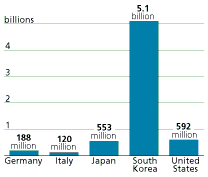Allison Tarmann
Editor, Population Today

May 1, 2000
Editor, Population Today
A draft report on replacement migration by the UN Population Division has captured the attention — and raised the eyebrows — of international audiences. The report’s projections, that over the next 50 years the populations of virtually all countries of Europe as well as Japan will face population decline and population aging, are not surprising. Its conclusion, however — that these twin challenges may require huge influxes of immigrants — has prompted swift reaction from across Europe and Asia.

Migrants needed by 2050 to maintain the ratio of workers to older people.
Source: UN Population Division, Replacement Migration, 2000.
Replacement Migration: Is It a Solution to Declining and Aging Populations? analyzes international migration that a country would need to offset population decline, offset declines in the working-age population, and maintain current ratios of workers to the over-65 population. The report examines replacement migration for eight low-fertility countries — France, Germany, Italy, Japan, South Korea, the Russian Federation, the United Kingdom, and the United States — and for Europe and the European Union.
Among its startling projections:
At the March annual meeting of the Population Association of America (PAA) in Los Angeles, demographers discussed the report.
Some maintained that the report contains nothing new. In response, Joseph Chamie, director of the UN Population Division, said that policymakers and government officials still have not taken projections of population aging and population decline seriously and that the public still does not grasp the implications of these expected trends. “What will happen,” he asked, “when the construction industry realizes that a shrinking and aging population won’t need new houses?”
But many took exception to the recommendations. David Coleman, reader in demography at the University of Oxford, called the report and the effort to compile it a good example of “demographism,” which he defined as an excessive reliance on narrow demographic statistics relating to the numbers of people, without regard to their characteristics and without regard to the consequences of such population change on social and political structures, community relations, or social cohesion. He pointed out that aging is not necessarily a bad thing because societies today and in the future can better cope with a lower support ratio by increasing labor productivity.
Antonio Golini, professor of demography at the University La Sapienza in Rome, said that immigration is necessary, especially for countries like Italy, to meet the exigencies of the labor market. “But it cannot be massive,” he said, “because of the presence in Europe of old minorities.”
Shigemi Kono, professor of demography at Reitaku University in Japan, offered alternatives to massive immigration. He suggested that small-scale industries should “abandon their easy and indulgent dependence on foreign workers.” He added that creating more opportunities for women and older workers could cut the reliance on immigrants to fill jobs in small-scale industry.
Outside of PAA, environmentalists have expressed frustration with the report. ECOPOP, an organization based in Switzerland, estimates that Western and Central Europe’s carrying capacity is 300 million people, living at a more modest consumption level than the current population of 445 million. “With the region already overpopulated, massive immigration cannot be a solution to these problems,” wrote ECOPOP secretary André Welti, who called the report “absurd.”
Meanwhile, Chamie is heartened, rather than subdued, by the continuing flood of calls, letters, e-mails, and media coverage-some of it critical. He welcomes the comments, though he called some of them unscientific. “[Jean-Marie] Le Pen’s [National Front] party in France sees the report as a recipe for cultural genocide. Others accuse us of ‘North Americanism.’ . . . Many people just don’t want to talk about migration,” he said.
Chamie emphasized the positive. The report, he said, unites many population subfields — declining fertility, increasing longevity, aging, international migration, projections — and this diversity of perspectives is useful for formulating population policy responses. He has received requests from Austria, Denmark, Norway, Poland, and Spain to include those countries in the final version of the report. And policymakers in developing countries have asked for additional analysis of the sources of the massive migration. They fear a large-scale exodus from their countries, draining away technical knowledge and causing social disruption. While Chamie said the report will be modified only slightly before it is finalized, he said it was possible that the UN Population Division would issue a series of related reports in answer to these requests.
Whatever the reaction to the report, it seems clear that if birth rates in the low-fertility countries do not increase, heightened immigration will hold more appeal than absolute decline.
For More Information
The report can be found on the website of the UN Population Division.
